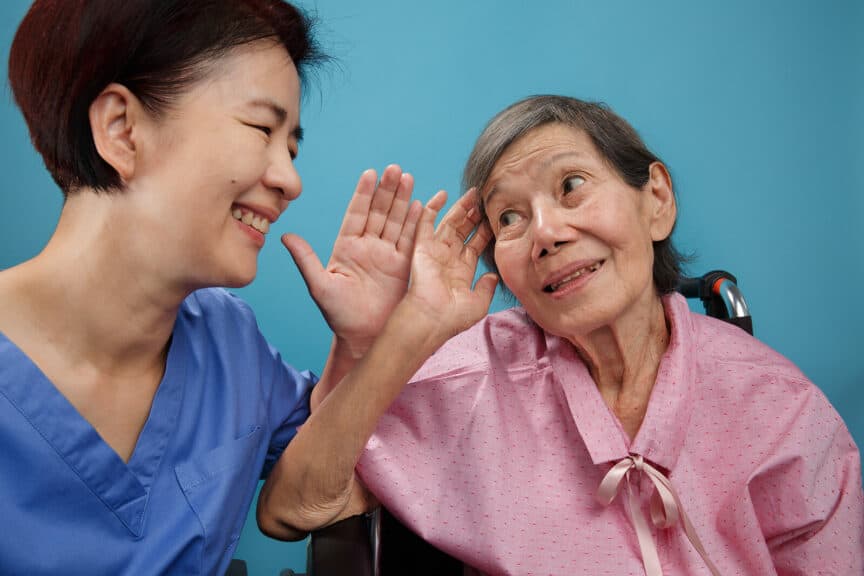Have you ever thought about how we are able to stand and move through space without falling? Though maintaining balance seems like an automatic process that just happens, it actually involves a complex process. The brain receives information from the body about spatial awareness and position which allows us to maintain balance. But there are ways these systems can be disrupted and damage causing balance issues or balance disorders.
The Balance System
The vestibular system is the sensory system for balance. It is located in the inner ear and consists of the vestibular labyrinth – a network of semicircular canals, otolith organs, and the vestibulocochlear nerve. The vestibular labyrinth works with other sensory inputs to send information about movement, position, and spatial orientation to the brain. This includes input from the eyes, joints, and muscles. These components detect information that is sent to the brain which provides feedback on how to move. This complex process is always occurring and is how we are able to maintain balance.
A closer look at how this works is useful to understanding how balance issues can occur. The semicircular canals in the inner ear are comprised of three loops or tubes that each detect a specific motion:
- First canal: up and down motions
- Second canal: side-to-side movements
- Third canal: tilting left and right movements
These canals are filled with fluid and sensory cells that act as receptors, sending information about movement and stability to the brain via the vestibulocochlear nerve. This information is collected from different sensory inputs like vision, muscles, and joints which helps the brain understand where the body is. This process can be disrupted and damaged in ways that affect balance and contribute to balance disorders.
Balance Disorders
Issues with maintaining balance can increase with age. It is estimated that 15% of adults (33 million) experience balance issues or dizziness. Additionally:
- 20% of adults ages 65-75 have a balance disorder.
- 25% of adults ages 75 and older have a balance disorder.
A balance disorder describes challenges with maintaining balance and/or experiencing vertigo. Vertigo is the experience of feeling like the room around you is spinning which produces bouts of dizziness. Balance disorders or challenges can be caused by a range of factors including: head injuries, hearing los, inner ear disorders like Meniere’s disease or benign paroxysmal positional vertigo (BPPV), viral or bacterial infections, high or low blood pressure, and medical conditions like Alzheimer’s and multiple sclerosis.
Balance disorders occur when signals related to movement and spatial orientation do not reach the brain. This can produce a range of symptoms including: bouts of dizziness, vertigo, unsteadiness, blurred vision, disorientation, nausea, motion sickness, and headaches. These symptoms can be intermittent or experienced more chronically which takes a toll on everyday life in significant ways. Symptoms can impact mobility and safety, prevent you from focusing and completing tasks, and cause you to feel unwell.
Hearing Loss & Balance
Both sensory systems for hearing and balance are in the inner ear. The ear plays a major role in how we hear and how we maintain balance. Hearing loss, one of the most common medical conditions people live with today, can then also impact balance. For example, inner ear disorders can cause both hearing loss and balance issues (this includes Meniere’s disease and BPPV). Hearing loss reduces capacity to hear and process speech as well as sound which produces various symptoms that strain hearing. This not only affects communication but also relationships, social life, and increases health risks. If you experience any symptoms related to balance and/or hearing loss, it is important to be evaluated by a healthcare specialist.
Treating Balance Disorders
Treating balance issues starts with being evaluated by a specialist that identifies and treats ear-related conditions. You can be referred to an ENT (ear, nose, throat) doctor or an audiologist. There are different tests that can be used to assess your symptoms and identify an underlying cause. This includes hearing tests, imaging tests, as well as evaluating blood samples. Depending on the underlying cause, balance disorders can be treated in the following ways:
- Medications: antibiotics can be prescribed to clear up bacterial infections. Your healthcare provider can also prescribe medications to alleviate common symptoms like dizziness and nausea.
- Vestibular Rehabilitation Therapy (VRT): this type of therapy focuses on performing movements without triggering dizziness or vertigo.
- Canalith repositioning: this treatment is specifically used to treat BPPV and involves repositioning the calcium crystals in the otolith organs that become dislodged.
These strategies can alleviate symptoms and provide relief. Contact us to learn more about balance disorders and approaches to treatment.

